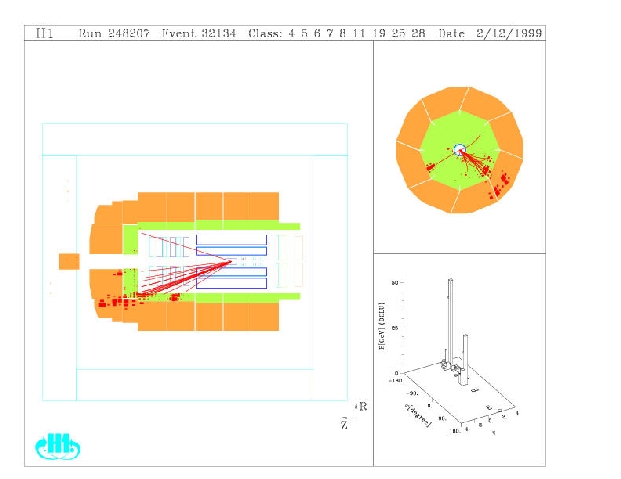Isolated electrons and muons in events with missing transverse momentum at HERA
|
Whilst many of the subatomic particles that
physicists at accelerators like HERA look for are directly observable
by the energy they deposit in a calorimeter or the curved path that a
charged particle takes through a tracking chamber, some particles are
more elusive. One such example is the ghostly neutrino which passes
through the detector with impunity, leaving no telltale energy or
track behind it. Other examples are heavy particles such as the
W± or Zo bosons which decay almost as soon
as they have been created - more precisely in 3 x 10-25
seconds - less than a million million million millionth of a second!
Such particles present physicists with a veritable sleuth's challenge,
where their brief or traceless presence in the detector can only be
inferred from other clues.
In the case of neutrinos, the clue lies in the
momentum which a neutrino carries away from an electron-proton
collision or "event". Since the incoming electron and proton approach
each other "head-on", basic mechanics tells us that in the aftermath
of the event an outgoing particle heading transverse to the direction
of the initial electron or proton must be balanced by another particle
heading the other way. This is a familar scenario on a billiard table
- if the cue ball heading down the centre of the table strikes a
target ball sitting on the centre spot, then if one ball richochets to
the right the other will certainly go left. Thus if physicists add up
the momenta of all the particles they observe in an event and are left
with a gap, there's good evidence that a neutrino escaped that
way.
Neutrinos are commonly produced at HERA, in so-called charged
current interactions, where the incoming electron is converted into a
neutrino. In these events a quark is struck out of the proton and
rapidly develops into a collimated spray of particles ("a jet"). The
characteristic signature of these events is the combination of such a
jet and a neutrino (inferred from the imbalance in summed
momenta). However, in identifying this type of event, a small subset
of events have been found where there is also a high energy electron
or muon observed, well separated from the jet. The Standard Model, the
state-of-the-art theory of modern particle physics, says that events
such as these are usually the result of a heavy W boson being fleetingly
produced, before decaying into an electron or muon, and a neutrino.
Examining the data that H1 collected during the
period 1994-2000, eighteen events are identified which contain an
isolated electron or muon and missing transverse momentum. The
Standard Model predicts 12.4 ± 1.7 events of this kind, the
majority coming from the decays of W bosons. Whilst these numbers are
broadly in agreement with each other, the comparison becomes more
interesting when the selection is restricted to those events which
have a particularly powerful jet. When this jet punches sideways
(transversely) into the detector with a momentum of more than 25 GeV
(approximately the momentum the electrons or positrons have when fully
accelerated by HERA), ten events are found compared to a Standard
Model expectation of 2.9 ± 0.5. The chance of a statistical
fluctuation producing this number of observed events is around 0.15%.
One of the selected events (containing an isolated electron) is
illustrated below in an "event display". This shows the tracks of
charged particles and energy depositions in the H1 detector, both in a
radial view (top right) and in a sideways projection (left). In this
event the decay electron can be seen in the lower-left section of the
radial view. The jet emerging from the proton can be seen
lower-right. The empty upper half of the radial view is the evidence
for the neutrino. It is events such as this, with a particularly
powerful jet, that are of greatest interest to the physicists studying
these processes. Since the jet is so powerful it is thought that it
develops from a quark recoiling against a heavy particle. The fact
that more events of this kind have been seen than are predicted could
indicate that a mechanism which is not currently part of the Standard
Model is enhancing the frequency of W bosons being produced. It might
even be the case that a different heavy particle is being momentarily
produced and decaying into products similar to those expected from W boson
decay. Only more data and more careful detective work will reveal the
truth.

Last Update on 22/01/2003 by Nick Malden
